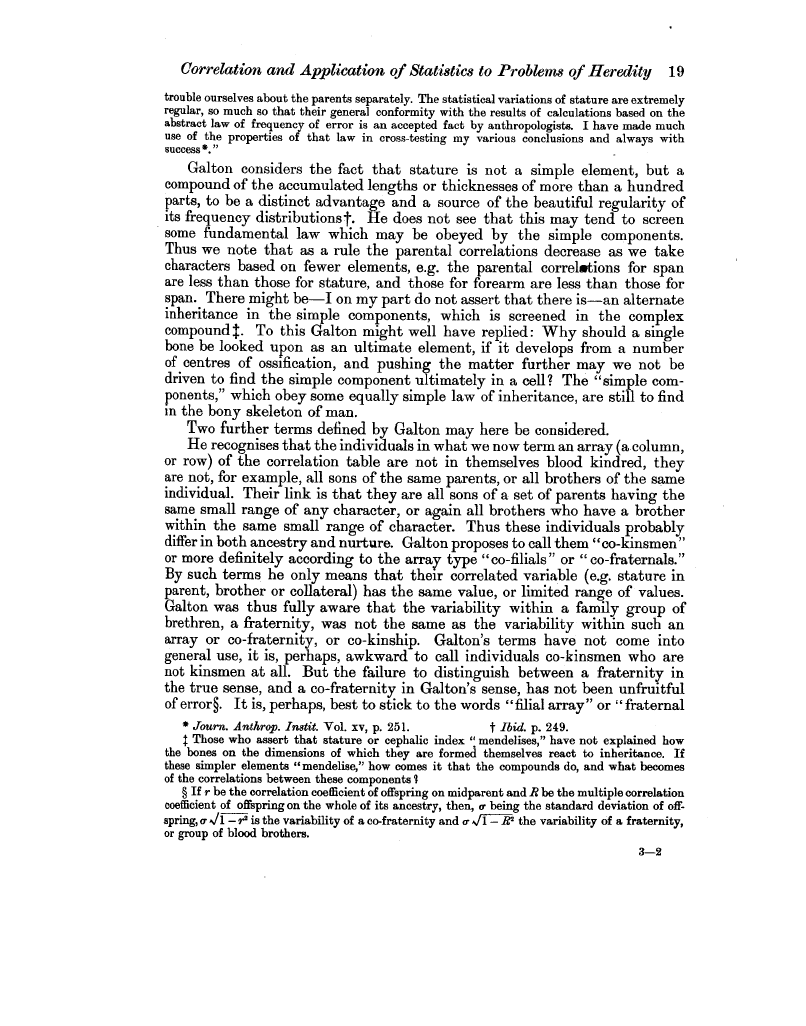| ||||||

OCR Rendition - approximate
Correlation and Application of Statistics to Problems of Heredity 19 trouble ourselves about the parents separately. The statistical variations of stature are extremely regular, so much so that their general conformity with the results of calculations based on the abstract law of frequency of error is an accepted fact by anthropologists. I have made much use of the properties of that law in cross-testing my various conclusions and always with success*. " Galton considers the fact that stature is not a simple element, but a compound of the accumulated lengths or thicknesses of more than a hundred parts, to be a distinct advantage and a source of the beautiful regularity of its frequency distributionst. He does not see that this may tend to screen some fundamental law which may be obeyed by the simple components. Thus we note that as a rule the parental correlations decrease as we take characters based on fewer elements, e.g. the parental correlations for span are less than those for stature, and those for forearm are less than those for span. There might be-I on my part do not assert that there is-an alternate inheritance in the simple components, which is screened in the complex compound T. To this Galton might well have replied : Why should a single bone be looked upon as an ultimate element, if it develops from a number of centres of ossification, and pushing the matter further may we not be driven to find the simple component ultimately in a cell? The "simple components," which obey some equally simple law of inheritance, are still to find in the bony skeleton of man. Two further terms defined by Galton may here be considered. He recognises that the individuals in what we now term an array (a column, or row) of the correlation table are not in themselves blood kindred, they are not, for example, all sons of the same parents, or all brothers of the same individual. Their link is that they are all sons of a set of parents having the same small range of any character, or again all brothers who have a brother within the same small range of character. Thus these individuals probably differ in both ancestry and nurture. Galton proposes to call them "co-kinsmen" or more definitely according to the array type "co-filials" or "co-fraternals." By such terms he only means that their correlated variable (e.g. stature in parent, brother or collateral) has the same value, or limited range of values. Galton was thus fully aware that the variability within a family group of brethren, a fraternity, was not the same as the variability within such an array or co-fraternity, or co-kinship. Galton's terms have not come into general use, it is, perhaps, awkward to call individuals co-kinsmen who are not kinsmen at all. But the failure to distinguish between a fraternity in the true sense, and a co-fraternity in Galton's sense, has not been unfruitful of error. It is, perhaps, best to stick to the words "filial array" or "fraternal * Journ. Anthrop. In.stit. Vol. xv, p. 251. t Ibid. p. 249. $ Those who assert that stature or cephalic index " mendelises," have not explained how the bones on the dimensions of which they are formed themselves react to inheritance. If these simpler elements 0' mendelise," how comes it that the compounds do, and what becomes of the correlations between these components 4 § If r be the correlation coefficient of offspring on midparent and R be the multiple correlation coefficient of offspring on the whole of its ancestry, then, v being the standard deviation of offspring, a 1/1-Y4 is the variability of a co-fraternity and o-,,/1- R2 the variability of a fraternity, or group of blood brothers. 3-2
|